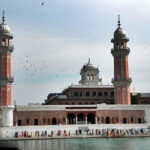While the Sikh community in Georgia is somewhat more recent, the earliest Sikhs in Afghanistan can be found in the 15th century.
The monotheistic religion of Sikhism was developed in 15th-century North India. The religion is thought to be the ninth most popular in the world and has between 25 and 28 million followers globally.
The Guru Granth Sahib, the religion’s sacred text, lays out its core precepts, which include social justice for all, equality for all humans, selfless service, and upright conduct.
The largest Sikh populations in India reside in Punjab and Haryana, however, the group is also well known for their global emigration. In the 19th century, a significant number of Sikhs immigrated to Canada, marking the beginning of global migration that has been recorded. Sikh communities can also be found in other nations, such as South East Asia, Africa, and the United Kingdom, which developed as a result of an initial labor shortage in those regions. However, this article examines two peculiar and obscure regions in the world—Afghanistan, and Georgia—where Sikhs have gone (the former Soviet Republic).
Afghanistan has Sikhs.
The earliest Sikhs, according to history, were those Afghans who adopted the religion after hearing Guru Nanak preach during his journey to Kabul in the 15th century. The population grew when Sikhs later travelled to the landlocked Central Asian nation for trade and continued to maintain ties with the mountainous nation thanks to British military operations.
The Sikh population, which is currently estimated to be around 8000 people, was once thought to number in the 50,000 range.
These Sikhs consider themselves Afghan citizens and are primarily found in the Afghan cities of Jalalabad, Kabul, and Kandahar.
Pashto is their primary language of choice, with Hindi and Punjabi being used as auxiliary languages.
Afghanistan’s constitution does recognize the rights of minority religions like Sikhism, even though Islam is the country’s official religion. Recent data, however, reveals that this recognition is merely symbolic. According to reports, Sikhs are frequently targeted for attacks because of their unusual physical look, which includes a turban, silver bangle, and curved sword. The local Islamic community, which views the practice of cremation of the dead as sacrilege, has also expressed anger at them due to their practice of cremation of the dead.
Most Sikhs left Afghanistan during the Afghan Civil War (1989–1996), and a sizable number also migrated during the Taliban era (1996–2001). While the Taliban formally recognized the community, they required Sikhs to identify themselves by donning yellow armbands or patches and flying yellow flags from their houses or places of business. Their financial condition has gotten worse because illegal land grabs have affected a large portion of their property.
Many Sikhs think that during the civil war and the Taliban’s rule, the local community has grown more biased toward them, which they do not think was the case before. Even though the Karzai government stopped illicit land seizures, recovering the land has been challenging. Most Sikhs left Afghanistan during the Afghan Civil War (1989–1996), and a sizable number also migrated during the Taliban era (1996–2001). While the Taliban formally recognized the community, they required Sikhs to identify themselves by donning yellow armbands or patches and flying yellow flags from their houses or places of business. Their financial condition has gotten worse because illegal land grabs have affected a large portion of their property.
Many Sikhs think that during the civil war and the Taliban’s rule, the local community has grown more biased toward them, which they do not think was the case before. Even though the Karzai government stopped illicit land seizures, recovering the land has been challenging. Most Sikhs left Afghanistan during the Afghan Civil War (1989–1996), and a sizable number also migrated during the Taliban era (1996–2001). While the Taliban formally recognized the community, they required Sikhs to identify themselves by donning yellow armbands or patches and flying yellow flags from their houses or places of business. Their financial condition has gotten worse because illegal land grabs have affected a large portion of their property.
Many Sikhs think that during the civil war and the Taliban’s rule, the local community has grown more biased toward them, which they do not think was the case before. Even though the Karzai government stopped illicit land seizures, recovering the land has been challenging. Most Sikhs left Afghanistan during the Afghan Civil War (1989–1996), and a sizable number also migrated during the Taliban era (1996–2001). While the Taliban formally recognized the community, they required Sikhs to identify themselves by donning yellow armbands or patches and flying yellow flags from their houses or places of business. Their financial condition has gotten worse because illegal land grabs have affected a large portion of their property.
Many Sikhs think that during the civil war and the Taliban’s rule, the local community has grown more biased toward them, which they do not think was the case before. Even though the Karzai government stopped illicit land seizures, recovering the land has been challenging. Most Sikhs left Afghanistan during the Afghan Civil War (1989–1996), and a sizable number also migrated during the Taliban era (1996–2001). While the Taliban formally recognized the community, they required Sikhs to identify themselves by donning yellow armbands or patches and flying yellow flags from their houses or places of business. Their financial condition has gotten worse because illegal land grabs have affected a large portion of their property.
Many Sikhs think that during the civil war and the Taliban’s rule, the local community has grown more biased toward them, which they do not think was the case before. Even though the Karzai government stopped illicit land seizures, recovering the land has been challenging. Most Sikhs left Afghanistan during the Afghan Civil War (1989–1996), and a sizable number also migrated during the Taliban era (1996–2001). While the Taliban formally recognized the community, they required Sikhs to identify themselves by donning yellow armbands or patches and flying yellow flags from their houses or places of business. Their financial condition has gotten worse because illegal land grabs have affected a large portion of their property.
Many Sikhs think that during the civil war and the Taliban’s rule, the local community has grown more biased toward them, which they do not think was the case before. Even though the Karzai government stopped illicit land seizures, recovering the land has been challenging. Most Sikhs left Afghanistan during the Afghan Civil War (1989–1996), and a sizable number also migrated during the Taliban era (1996–2001). While the Taliban formally recognized the community, they required Sikhs to identify themselves by donning yellow armbands or patches and flying yellow flags from their houses or places of business. Their financial condition has gotten worse because illegal land grabs have affected a large portion of their property.
Many Sikhs think that during the civil war and the Taliban’s rule, the local community has grown more biased toward them, which they do not think was the case before. Even though the Karzai government stopped illicit land seizures, recovering the land has been challenging. Most Sikhs left Afghanistan during the Afghan Civil War (1989–1996), and a sizable number also migrated during the Taliban era (1996–2001). While the Taliban formally recognized the community, they required Sikhs to identify themselves by donning yellow armbands or patches and flying yellow flags from their houses or places of business. Their financial condition has gotten worse because illegal land grabs have affected a large portion of their property.
Many Sikhs think that during the civil war and the Taliban’s rule, the local community has grown more biased toward them, which they do not think was the case before. Even though the Karzai government stopped illicit land seizures, recovering the land has been challenging. Most Sikhs left Afghanistan during the Afghan Civil War (1989–1996), and a sizable number also migrated during the Taliban era (1996–2001). While the Taliban formally recognized the community, they required Sikhs to identify themselves by donning yellow armbands or patches and flying yellow flags from their houses or places of business. Their financial condition has gotten worse because illegal land grabs have affected a large portion of their property.
Many Sikhs think that during the civil war and the Taliban’s rule, the local community has grown more biased toward them, which they do not think was the case before. Even though the Karzai government stopped illicit land seizures, recovering the land has been challenging. Most Sikhs left Afghanistan during the Afghan Civil War (1989–1996), and a sizable number also migrated during the Taliban era (1996–2001). While the Taliban formally recognized the community, they required Sikhs to identify themselves by donning yellow armbands or patches and flying yellow flags from their houses or places of business. Their financial condition has gotten worse because illegal land grabs have affected a large portion of their property.
Many Sikhs think that during the civil war and the Taliban’s rule, the local community has grown more biased toward them, which they do not think was the case before. Even though the Karzai government stopped illicit land seizures, recovering the land has been challenging. Most Sikhs left Afghanistan during the Afghan Civil War (1989–1996), and a sizable number also migrated during the Taliban era (1996–2001). While the Taliban formally recognized the community, they required Sikhs to identify themselves by donning yellow armbands or patches and flying yellow flags from their houses or places of business. Their financial condition has gotten worse because illegal land grabs have affected a large portion of their property.
Many Sikhs think that during the civil war and the Taliban’s rule, the local community has grown more biased toward them, which they do not think was the case before. Even though the Karzai government stopped illicit land seizures, recovering the land has been challenging. Most Sikhs left Afghanistan during the Afghan Civil War (1989–1996), and a sizable number also migrated during the Taliban era (1996–2001). While the Taliban formally recognized the community, they required Sikhs to identify themselves by donning yellow armbands or patches and flying yellow flags from their houses or places of business. Their financial condition has gotten worse because illegal land grabs have affected a large portion of their property.
Many Sikhs think that during the civil war and the Taliban’s rule, the local community has grown more biased toward them, which they do not think was the case before. Even though the Karzai government stopped illicit land seizures, recovering the land has been challenging.








